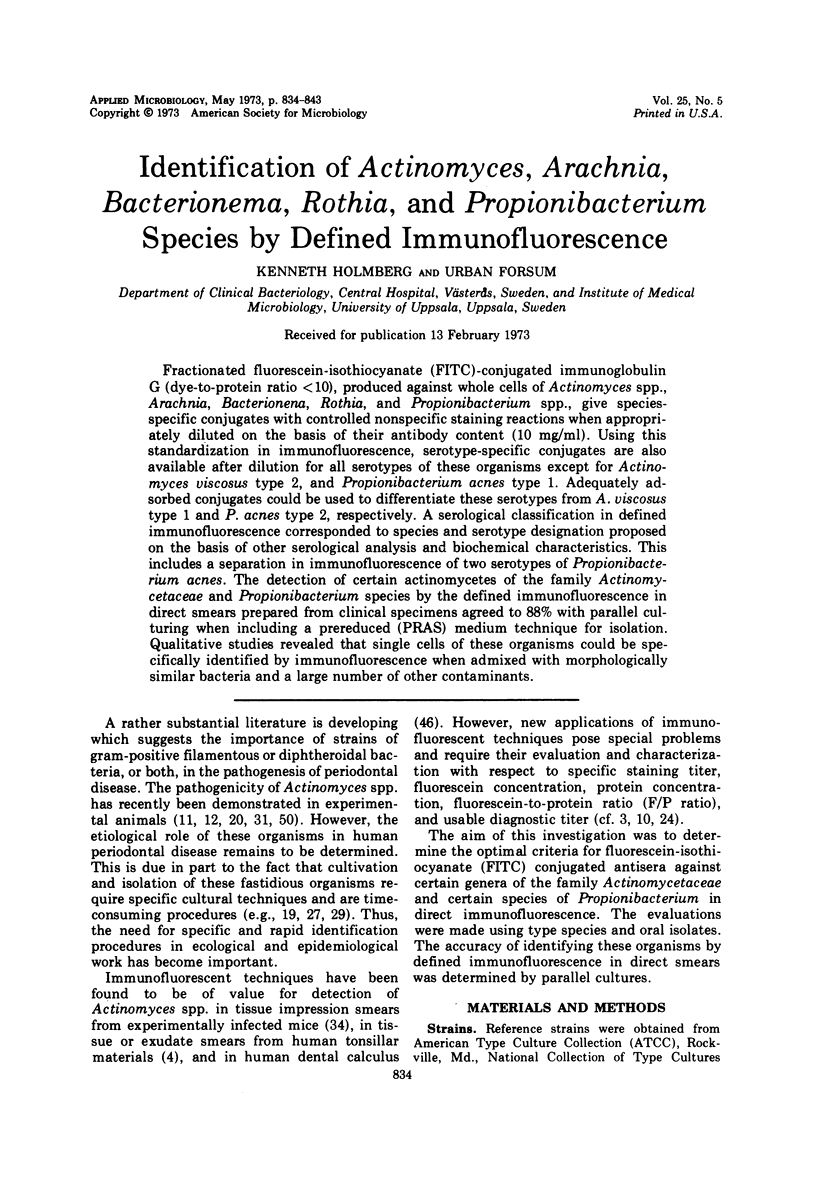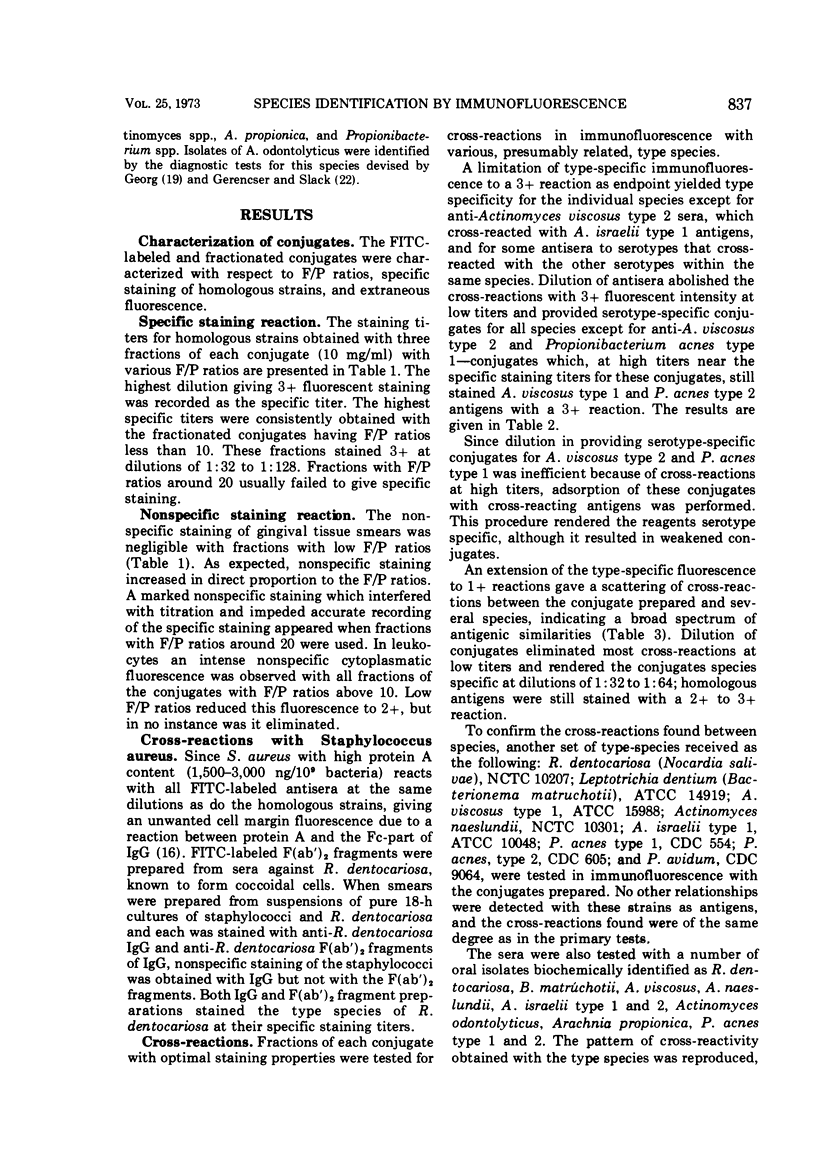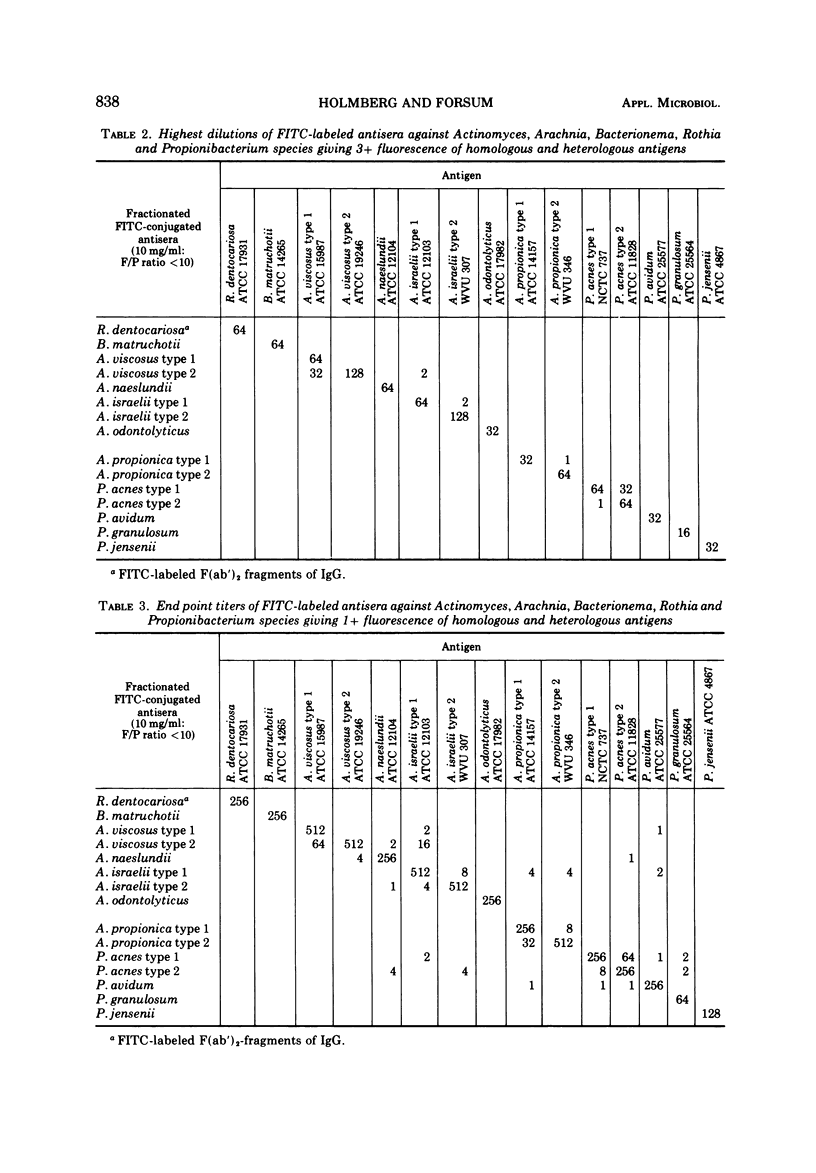Abstract
Fractionated fluorescein-isothiocyanate (FITC)-conjugated immunoglobulin G (dye-to-protein ratio <10), produced against whole cells of Actinomyces spp., Arachnia, Bacterionena, Rothia, and Propionibacterium spp., give species-specific conjugates with controlled nonspecific staining reactions when appropriately diluted on the basis of their antibody content (10 mg/ml). Using this standardization in immunofluorescence, serotype-specific conjugates are also available after dilution for all serotypes of these organisms except for Actinomyces viscosus type 2, and Propionibacterium acnes type 1. Adequately adsorbed conjugates could be used to differentiate these serotypes from A. viscosus type 1 and P. acnes type 2, respectively. A serological classification in defined immunofluorescence corresponded to species and serotype designation proposed on the basis of other serological analysis and biochemical characteristics. This includes a separation in immunofluorescence of two serotypes of Propionibacterium acnes. The detection of certain actinomycetes of the family Actinomycetaceae and Propionibacterium species by the defined immunofluorescence in direct smears prepared from clinical specimens agreed to 88% with parallel culturing when including a prereduced (PRAS) medium technique for isolation. Qualitative studies revealed that single cells of these organisms could be specifically identified by immunofluorescence when admixed with morphologically similar bacteria and a large number of other contaminants.
Full text
PDF









Selected References
These references are in PubMed. This may not be the complete list of references from this article.
- BEERENS H. Etude comparative de six souches de bactéries anaérobies non sporulées: Actinomyces bovis A.T.C.C 8373 (bovine), A. bovis A.T.C.C. 8374 (humaine), A. israeli var. liquefaciens, Corynebacterium acnes, Corynebacterium avidum, Corynebacterium liquefaciens. Ann Inst Pasteur (Paris) 1953 Jun;84(6):1026–1032. [PubMed] [Google Scholar]
- BRZIN B. STUDIES ON THE CORYNEBACTERIUM ACNES. Acta Pathol Microbiol Scand. 1964;60:599–608. doi: 10.1111/apm.1964.60.4.599. [DOI] [PubMed] [Google Scholar]
- BUCHANAN B. B., PINE L. Characterization of a propionic acid producing actinomycete, Actinomyces propionicus, sp. nov. J Gen Microbiol. 1962 Jun;28:305–323. doi: 10.1099/00221287-28-2-305. [DOI] [PubMed] [Google Scholar]
- Bellack S., Jordan H. V. Serological identification of rodent strains of Actinomyces viscosus and their relationship to Actinomyces of human origin. Arch Oral Biol. 1972 Jan;17(1):175–182. doi: 10.1016/0003-9969(72)90145-8. [DOI] [PubMed] [Google Scholar]
- Beutner E. H. Defined immunofluorescent staining: past progress, present status, and future prospects for defined conjugates. Ann N Y Acad Sci. 1971 Jun 21;177:506–526. doi: 10.1111/j.1749-6632.1971.tb35081.x. [DOI] [PubMed] [Google Scholar]
- Boone C. J., Pine L. Rapid method for characterization of actinomycetes by cell wall composition. Appl Microbiol. 1968 Feb;16(2):279–284. doi: 10.1128/am.16.2.279-284.1968. [DOI] [PMC free article] [PubMed] [Google Scholar]
- Brock D. W., Georg L. K. Determination and analysis of Actinomyces israelii serotypes by fluorescent-antibody procedures. J Bacteriol. 1969 Feb;97(2):581–588. doi: 10.1128/jb.97.2.581-588.1969. [DOI] [PMC free article] [PubMed] [Google Scholar]
- Brown J. M., Georg L. K., Waters L. C. Laboratory identification of Rothia dentocariosa and its occurrence in human clinical materials. Appl Microbiol. 1969 Jan;17(1):150–156. doi: 10.1128/am.17.1.150-156.1969. [DOI] [PMC free article] [PubMed] [Google Scholar]
- CHERRYWBMOODY M. D. FLUORESCENT-ANTIBODY TECHNIQUES IN DIAGNOSTIC BACTERIOLOGY. Bacteriol Rev. 1965 Jun;29:222–250. [PMC free article] [PubMed] [Google Scholar]
- Coleman R. M., Georg L. K. Comparative pathogenicity of Actinomyces naeslundii and Actinomyces israelii. Appl Microbiol. 1969 Sep;18(3):427–432. doi: 10.1128/am.18.3.427-432.1969. [DOI] [PMC free article] [PubMed] [Google Scholar]
- Coleman R. M., Georg L. K., Rozzell A. R. Actinomyces naeslundii as an agent of human actinomycosis. Appl Microbiol. 1969 Sep;18(3):420–426. doi: 10.1128/am.18.3.420-426.1969. [DOI] [PMC free article] [PubMed] [Google Scholar]
- DAVIS G. H., FREER J. H. Studies upon an oral aerobic actinomycete. J Gen Microbiol. 1960 Aug;23:163–178. doi: 10.1099/00221287-23-1-163. [DOI] [PubMed] [Google Scholar]
- Forsgren A., Forsum U. Role of Protein A in Nonspecific Immunofluorescence of Staphylococcus aureus. Infect Immun. 1970 Oct;2(4):387–391. doi: 10.1128/iai.2.4.387-391.1970. [DOI] [PMC free article] [PubMed] [Google Scholar]
- Forsum U. Characterization of FITC-labelled F(ab')2 fragments of IgG and a rapid technique for the separation of optimally labelled fragments. J Immunol Methods. 1973 Jan;2(2):183–195. doi: 10.1016/0022-1759(73)90015-x. [DOI] [PubMed] [Google Scholar]
- Georg L. K., Coleman R. M., Brown J. M. Evaluation of an agar precipitin test for the serodiagnosis of actinomycosis. J Immunol. 1968 Jun;100(6):1288–1292. [PubMed] [Google Scholar]
- Gerencser M. A., Slack J. M. Identification of human strains of Actinomyces viscosus. Appl Microbiol. 1969 Jul;18(1):80–87. doi: 10.1128/am.18.1.80-87.1969. [DOI] [PMC free article] [PubMed] [Google Scholar]
- Gerencser M. A., Slack J. M. Isolation and characterization of Actinomyces propionicus. J Bacteriol. 1967 Jul;94(1):109–115. doi: 10.1128/jb.94.1.109-115.1967. [DOI] [PMC free article] [PubMed] [Google Scholar]
- Hammond B. F. Isolation and serological characterization of a cell wall antigen of Rothia dentocariosa. J Bacteriol. 1970 Sep;103(3):634–640. doi: 10.1128/jb.103.3.634-640.1970. [DOI] [PMC free article] [PubMed] [Google Scholar]
- Holmberg K., Hallander H. O. Numerical taxonomy and laboratory identification of Bacterionema matruchotii, Rothia dentocariosa, Actinomyces naeslundii, Actinomyces viscosus, and some related bacteria. J Gen Microbiol. 1973 May;76(1):43–63. doi: 10.1099/00221287-76-1-43. [DOI] [PubMed] [Google Scholar]
- Johnson J. L., Cummins C. S. Cell wall composition and deoxyribonucleic acid similarities among the anaerobic coryneforms, classical propionibacteria, and strains of Arachnia propionica. J Bacteriol. 1972 Mar;109(3):1047–1066. doi: 10.1128/jb.109.3.1047-1066.1972. [DOI] [PMC free article] [PubMed] [Google Scholar]
- Jordan H. V., Keyes P. H., Bellack S. Periodontal lesions in hamsters and gnotobiotic rats infected with actinomyces of human origin. J Periodontal Res. 1972;7(1):21–28. doi: 10.1111/j.1600-0765.1972.tb00627.x. [DOI] [PubMed] [Google Scholar]
- KROEGER A. V., SIBAL L. R. Biochemical and serological reactions of an oral filamentous organism. J Bacteriol. 1961 Apr;81:581–585. doi: 10.1128/jb.81.4.581-585.1961. [DOI] [PMC free article] [PubMed] [Google Scholar]
- Lambert F. W., Jr, Brown J. M., Georg L. K. Identification of Actinomyces israelii and Actinomyces naeslundii by fluorescent-antibody and agar-gel diffusion techniques. J Bacteriol. 1967 Nov;94(5):1287–1295. doi: 10.1128/jb.94.5.1287-1295.1967. [DOI] [PMC free article] [PubMed] [Google Scholar]
- NISONOFF A. ENZYMATIC DIGESTION OF RABBIT GAMMA GLOBULIN AND ANTIBODY AND CHROMATOGRAPHY OF DIGESTION PRODUCTS. Methods Med Res. 1964;10:134–141. [PubMed] [Google Scholar]
- Pittman B., Herbert G. A., Cherry W. B., Taylor G. C. The quantitation of nonspecific staining as a guide for improvement of fluorescent antibody conjugates. J Immunol. 1967 Jun;98(6):1196–1203. [PubMed] [Google Scholar]
- RUSSELL A. L. A system of classification and scoring for prevalence surveys of periodontal disease. J Dent Res. 1956 Jun;35(3):350–359. doi: 10.1177/00220345560350030401. [DOI] [PubMed] [Google Scholar]
- Ritz H. L. Fluorescent antibody staining of Neisseria, Streptococcus and Veillonella in frozen sections of human dental plaque. Arch Oral Biol. 1969 Sep;14(9):1073–1083. doi: 10.1016/0003-9969(69)90077-6. [DOI] [PubMed] [Google Scholar]
- SCHEIDEGGER J. J. Une micro-méthode de l'immuno-electrophorèse. Int Arch Allergy Appl Immunol. 1955;7(2):103–110. [PubMed] [Google Scholar]
- Slack J. M., Gerencser M. A. Revision of serological grouping of Actinomyces. J Bacteriol. 1966 May;91(5):2107–2107. doi: 10.1128/jb.91.5.2107-.1966. [DOI] [PMC free article] [PubMed] [Google Scholar]
- Slack J. M., Gerencser M. A. Two new serological groups of Actinomyces. J Bacteriol. 1970 Jul;103(1):265–266. doi: 10.1128/jb.103.1.265-266.1970. [DOI] [PMC free article] [PubMed] [Google Scholar]
- Slack J. M., Landfried S., Gerencser M. A. Identification of Actinomyces and related bacteria in dental calculus by the fluorescent antibody technique. J Dent Res. 1971 Jan-Feb;50(1):78–82. doi: 10.1177/00220345710500013501. [DOI] [PubMed] [Google Scholar]
- Slack J. M., Landfried S., Gerencser M. A. Morphological, biochemical, and serological studies on 64 strains of Actinomyces israelii. J Bacteriol. 1969 Feb;97(2):873–884. doi: 10.1128/jb.97.2.873-884.1969. [DOI] [PMC free article] [PubMed] [Google Scholar]
- Slack J. M., Winger A., Moore D. W. SEROLOGICAL GROUPING OF ACTINOMYCES BY MEANS OF FLUORESCENT ANTIBODIES. J Bacteriol. 1961 Jul;82(1):54–65. doi: 10.1128/jb.82.1.54-65.1961. [DOI] [PMC free article] [PubMed] [Google Scholar]
- Snyder M. L., Slawson M. S., Bullock W., Parker R. B. Studies on oral filamentous bacteria. II. Serological relationships within the genera Actinomyces, Nocardia, Bacterionema and Leptotrichia. J Infect Dis. 1967 Oct;117(4):341–345. doi: 10.1093/infdis/117.4.341. [DOI] [PubMed] [Google Scholar]
- Socransky S. S., Hubersak C., Propas D. Induction of periodontal destruction in gnotobiotic rats by a human oral strain of Actinomyces naeslundii. Arch Oral Biol. 1970 Oct;15(10):993–995. doi: 10.1016/0003-9969(70)90095-6. [DOI] [PubMed] [Google Scholar]
- Socransky S. S. Relationship of bacteria to the etiology of periodontal disease. J Dent Res. 1970 Mar-Apr;49(2):203–222. doi: 10.1177/00220345700490020401. [DOI] [PubMed] [Google Scholar]
- The T. H., Feltkamp T. E. Conjugation of fluorescein isothiocyanate to antibodies. I. Experiments on the conditions of conjugation. Immunology. 1970 Jun;18(6):865–873. [PMC free article] [PubMed] [Google Scholar]
- Voss J. G. Differentiation of two groups of Corynebacterium acnes. J Bacteriol. 1970 Feb;101(2):392–397. doi: 10.1128/jb.101.2.392-397.1970. [DOI] [PMC free article] [PubMed] [Google Scholar]
- Wells A. F., Miller C. E., Nadel M. K. Rapid fluorescein and protein assay method for fluorescent-antibody conjugates. Appl Microbiol. 1966 Mar;14(2):271–275. doi: 10.1128/am.14.2.271-275.1966. [DOI] [PMC free article] [PubMed] [Google Scholar]


